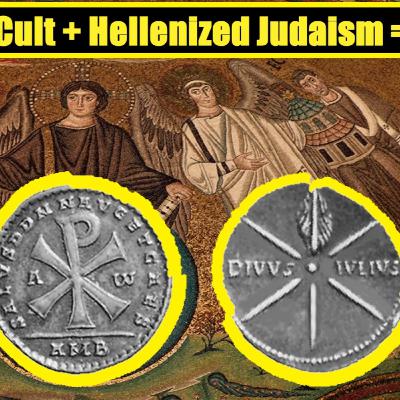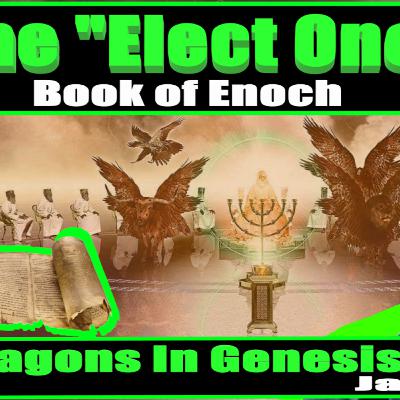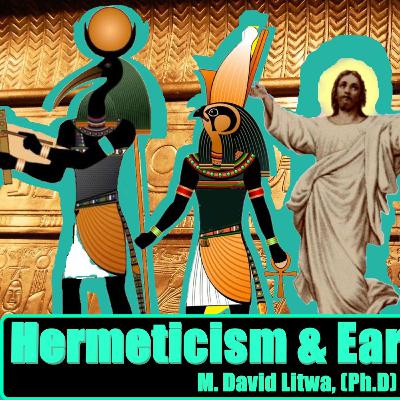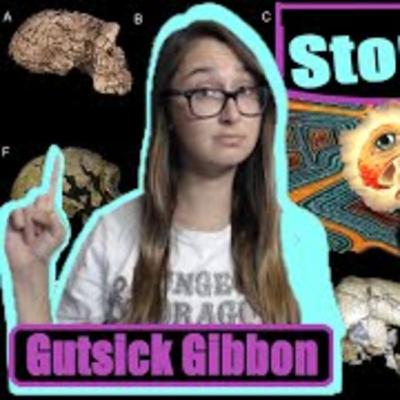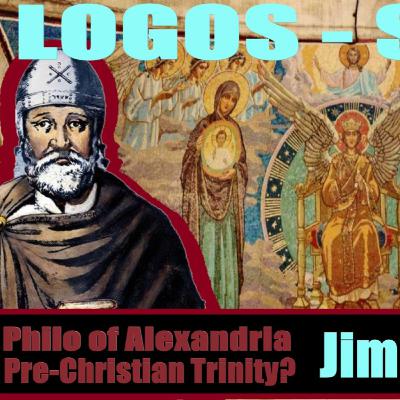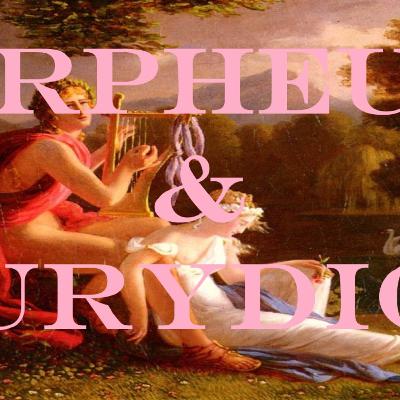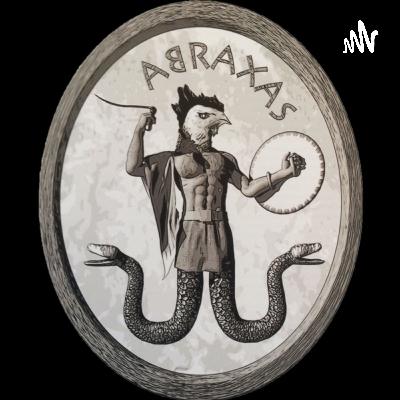Discover Gnostic Informant
Gnostic Informant

94 Episodes
Reverse
We discuss how Elite Roman Imperial Cultists played a heavy role in transforming Hellenistic Judaism into Pauline Christianity. We also discuss the possibility that Josephus and the Flavian Dynasty polemicized the Jews with the Sacking of Jerusalem by Titus and left a trace in the writings of the Gospels. Did the 7 year tribulation already happen during the Roman-Jewish War from 66-74 C.E.?
James S. Valliant: https://www.creatingchrist.com/
#RomanProvenance #JamesValliant #Christianity #Gnostic #GnosticInformant
The Book of Enoch was preserved among the Ethiopian Jews & Christians in the Ge'ez Language, and was also present among the Dead Sea Scrolls in Hebrew & Aramaic fragments. This text was extremely important to early Christians and we demonstrate why that is so in this video. Jason Foux: https://www.dragonsingenesis.com/Youtube: https://www.youtube.com/c/DragonsinGenesisPodcast #Enoch #DragonsInGenesis #Christianity #Gnostic #GnosticInformant
Dr. M. David Litwa is a current Research Fellow, Institute for Religion and Critical Inquiry, Australian Catholic University, Australia Co-coordinator, Biblical and Early Christian Studies Seminar Library Liaison Doctor of Philosophy (Ph.D.) University of Virginia Master of Theology (Th.M.) Duke University Master of Divinity (M.Div.) Emory University Instructor in Early Christianity, Virginia Tech Department of Religion and Culture, USA from August 2016 to June 2017 Lecturer in Classics, College of William & Mary, USA from January to May 2016 Lecturer in Classics, University of Virginia, USA from January 2013 to May 2015 Steering Committee for Bible, Myth, and Myth Theory, Society of Biblical Literature from 2015 to the present In this video we discuss Litwa's book, "Hermetica II" which is a scholarly translation of the Hermetic Texts from ancient egypt of the Hellenistic Age. We compare and contrast the Mystery cults of Hermes, Horus, Dionysus, and Jesus. Hermetica II: The Excerpts of Stobaeus, Papyrus Fragments, and Ancient Testimonies in a English Translation with Notes and Introductions (Cambridge: Cambridge University Press, 2018). He has also written: How the Gospels Became History: Jesus and Mediterranean Myths (New Haven: Yale University Press, 2019). Desiring Divinity: Self-deification in Ancient Jewish and Christian Mythmaking. Forthcoming from Oxford University Press, 2016. Refutation of All Heresies: Text, Translation, and Notes, Writings from the Greco-Roman World 40 (Atlanta: SBL Press, 2015). Iesus Deus: The Early Christian Depiction of Jesus as a Mediterranean God (Minneapolis: Fortress Academic, 2014). Becoming Divine: An Introduction to Deification in Western Culture (Eugene, OR: Cascade, 2013) We Are Being Transformed: Deification in Paul’s Soteriology (Beihefte zum Zeitschrift für Neutestamentliche Wissenschaft 187; Berlin & New York: Walter de Gruyter, 2012). Forthcoming: Found Christianities: Remaking the World of the Second Century Coming March 2022 from Bloomsbury For more from M. David Litwa: https://mdavidlitwa.wordpress.com/about/ https://www.acu.edu.au/research/our-research-institutes/institute-for-religion-and-critical-inquiry/our-people/m-david-litwa https://www.amazon.com/M.-David-Litwa/e/B00J5VOVCS%3Fref=dbs_a_mng_rwt_scns_share #MDavidLitwa #Hermetica #MysteryCults #Gnostic #GnosticInformant
In this video M. David Litwa, PhD, joins me to discuss the possibility that the Ancient Israelites may have had an anthropomorphic Donkey Deity who is known to the Egyptians as Seth, Set, or SATA-NU. We discuss if there is a connection to Seth, the God of Chaos and Saturn/Kronos, the Son of Chaos and Evil Creator. The concept of the Demiurge was written about by Plato and the Gnostics, in which the Creator of the World is Evil and needs saving from. Tacitus is a 2nd century author who describes the origins of the Israelites as finding salvation after the Exodus in the Desert by following Donkeys to water. Tacitus also tells us that the Israelites worship Saturn and purposely chose to worship the opposite Deity to the Egyptians, due to being kicked out of the country. Zechariah is said to have witnessed a Donkey Deity in the Holy of Holies who caused him to become mute. Antiochus IV sacked the Temple and reported to find a Golden Head of a Donkey similar to the head of Egyptian Seth. We discuss if these sources are connected. Marcion is an early Church father who was a Gnostic and thought that Jesus was the Son of a different God than the God of the Jews. We also dig deep into the History of Marcion and the Gnostics. For the Evil Creator: https://www.amazon.com/Evil-Creator-Origins-Early-Christian/dp/0197566421 David Litwa on WordPress: https://mdavidlitwa.wordpress.com/ More David Litwa Works: https://www.amazon.com/M-David-Litwa/e/B00J5VOVCS/ref=dp_byline_cont_pop_book_1 #DavidLitwa #TheEvilCreator #DonkeyDeity #Demiurge #Set #Seth #Saturn #Satan #Gnostic #GnosticInformant
Erika is a soon to be PhD, Evolution Expert. She is known for youtube channel about Evolution and her epic debates against Christian apologists such as Kent Hovind. In this video we discuss Terrence McKenna's Stoned Ape Hypothesis. Erika lays out what could still be correct about the hypothesis as well as explain the problems with the data and timeline. We also discuss Transitional Fossils and why Evolution is a fact. Youtube: @Gutsick Gibbon For Gutsick Gibbon Patreon: https://www.patreon.com/GutsickGibbon #GutsickGibbon #Evolution #StonedApeTheory #Gnostic #GnosticInformant
Philo of Alexandria, (20 BCE – c. 50 CE), also called Philo Judaeus, was a Hellenistic Jewish philosopher who lived in Alexandria, in the Roman province of Egypt. Many of his works are survived to us through the Church, such as his writings on the Trinity, the Logos, and other Hellenistic Jewish ideas that influenced early Christianity. Jim Majors, Ph.D Twitter: https://twitter.com/TheJimMajorsJim Majors on Youtube: @Jim Majors #JimMajors #Philo #Logos #Gnostic #GnosticInformant
Tovia Singer is the founder and director of Outreach Judaism, a Jewish counter-missionary organization. It describes itself as "an international organization that responds directly to the issues raised by missionaries and cults, by exploring Judaism in contradistinction to fundamentalist Christianity." Singer cautions regarding congregations that "are designed to appear Jewish, but are actually fundamentalist Christian churches, which use traditional Jewish symbols to lure the most vulnerable of our Jewish people into their ranks." Outreach Judaism was described by J. Gordon Melton in 2002 as an example of "the current state of Jewish counter-cult activity." Tovia Singer engages in numerous disputes with Christianity including that of Blood Atonement or the Passion of Jesus. In this video, we demonstrate beyond all doubts why Christianity is diametrically opposed to Judaism and why Jesus did not fulfill the messianic requirements, let alone be God of Israel. We also discuss the Jesus of the Talmud and offer some hot, never before heard takes on the Historicity of Jesus and Joseph. For more from Rabbi Tovia Singer http://www.toviasinger.tv/Check out Rabbi Tovia Singer on Youtube: @Tovia Singer #ToviaSinger #Judaism #Christianity #Messiah #Gnostic #GnosticInformant
Lawrence Krauss is an internationally known theoretical physicist and bestselling author, as well as being an acclaimed lecturer. He is currently President of The Origins Project Foundation, and host of The Origins Podcast, His wide research interests have focused on the interface between elementary particle physics and cosmology, including the origin and evolution of the Universe and the fundamental structure of matter. Among his numerous important scientific contributions was the proposal, in 1995, that most of the energy of the Universe resided in empty space. Krauss previously served as Director of Arizona State University's Origins Project, and Foundation Professor for a decade from 2008-2018, and also as Chair of the Board of Sponsors of the Bulletin of the Atomic Scientists from 2006-2018. During his career Prof. Krauss has held endowed professorships and distinguished research appointments at institutions including Harvard University, Yale University, University of Chicago, Boston University, University of Zurich, University of California at Santa Barbara, Lawrence Berkeley Laboratory, the European Center for Nuclear Research (CERN), Case Western Reserve University, Australian National University, Arizona State University, and New College of Humanities. In 2008 he created and served for a decade as Inaugural Director of the Origins Project, a national center for research and outreach on origins issues, from the origins of the universe, to human origins, to the origins of the consciousness and culture. He has written over 500 publications and 10 popular books, including the international best-sellers, The Physics of Star Trek and A Universe from Nothing. His latest book, The Greatest Story Ever Told--So Far was released in March 2017. He has written regularly for magazines and newspapers including The New York Times and the New Yorker, and appears regularly on radio, television and most recently in several feature films. Among his numerous awards are included the three major awards from all 3 US physics societies and the 2012 Public Service Award from the National Science Board for his contributions to the public understanding of science.
Awards: Gravity Research Foundation First Prize Award in the 1984 Essay Competition Presidential Investigator Award (1986) American Association for the Advancement of Science's Award for the Public Understanding of Science and Technology (2000) Julius Edgar Lilienfeld Prize (2001) Andrew Gemant Award (2001) American Institute of Physics Science Writing Award (2002) Oersted Medal (2003) American Physical Society Joseph P. Burton Forum Award (2005) Center for Inquiry World Congress Science in the Public Interest Award (2009) Helen Sawyer Hogg Prize of the Royal Astronomical Society of Canada and the Astronomical Society of Canada (2009) Physics World Book of the Year 2011 for Quantum Man National Science Board 2012 Public Service Award and Medal (2012) Premio Roma "Urbs Universalis", Rome (2013) Elected as Laureate of the International Academy of Humanism (2013)[ AFO (Academia Film Olomouc) Award for Outstanding Personal Contribution to the Popularization of Science, 49th Annual AFO Festival April 19, 2014. Olomouc, Czech Republic Gravity Research Foundation First Prize Award in the 2014 Essay Competition Humanist of the Year, 2015, American Humanist Association Richard Dawkins Award 2016, Atheist Alliance of America Emperor Has No Clothes Award 2016, Freedom from Religion Foundation Albert Nelson Marquis Lifetime Achievement Award 2019.Marquis Who's Who Elected to Advisory Council, Atheist Alliance International, 2020
Jonathan M.S. Pearce is a teacher from south Hampshire, UK, who has dedicated many years to studying all manner of things philosophical and theological. Having studied for a Masters in Philosophy from the University of Wales, TSD, he also holds a degree from the University of Leeds, and a PGCE from the University of St Mary's, Twickenham. As a founder member of the Tippling Philosophers, a friendly group of disparate believers and non-believers based in Hampshire, he is a big advocate of casual philosophy groups meeting over pints of good ale. He lives with his partner and wonders how she puts up with him. Pearce has completed a number of titles: Free Will?, The Little Book of Unholy Questions, The Nativity: A Critical Examination, The Problem with "God", 13 Reasons to Doubt and Beyond an Absence of Faith. He has also made many public speaking engagements, discussing philosophy, religion and skepticism. His Channel can be found here: http://www.youtube.com/user/johnnyp76... He #jonathanmspearce #resurrection #acriticalexamination#Gnostic #GnosticInformant
Dr. Michael Shermer is the Founding Publisher of Skeptic magazine, the host of the podcast The Michael Shermer Show, and a Presidential Fellow at Chapman University where he teaches Skepticism 101. For 18 years he was a monthly columnist for Scientific American. He is the author of New York Times bestsellers Why People Believe Weird Things and The Believing Brain, Why Darwin Matters, The Science of Good and Evil, The Moral Arc, Heavens on Earth, and Giving the Devil His Due: Reflections of a Scientific Humanist. Follow him on Twitter @michaelshermer. @MythVision Podcast @Skeptic Agenticity, the tendency to confuse patterns with a central agency. (God must of shot lightning at us) Patternicity, the tendency to find meaningful patterns in random noise. (Seeing Jesus' face on toast) Also, how fundamentalist theists use Deist arguments to defend belief systems that are not backed by any sound data. https://michaelshermer.com/ https://www.skeptic.com/ Derek Lambert: https://mythvisionpodcast.com/ #MichaelShermer #TheBelievingBrain #DerekLambert #MythVision #Gnostic #GnosticInformant
History of Mithra, from the Vedic Mitra-Varuna to Mithra Sol-Invictus of the Roman Empire. In this video we discuss how the Ancient Rites of the Magi in Ancient Iran influenced the main 3 religions of the west, Judaism, Christianity, and Islam. Links for Dr. Jason Reza Jorjani: https://jasonrezajorjani.com/ #JasonRezaJorjani #Mithra #Magi #Gnostic #GnosticInformant
Alexander the Great was more than just a conquerer. He was the Son of Ammun. His mother Olympias was larger than life and stronger than any of the Men who tried to subdue her. Tutored by Aristotle and raised by Philip of Macedon, Alexander was destined to Rule the World with the guidance of Olympias.
Jacob Berman from History Valley joins me to discuss the Historical & Allegorical layers of the New Testament as well as other topics regarding 1st century history of Roman Judea.
Jacob's Channel : https://www.youtube.com/channel/UC4yzcsaYuPJfPymf2arGCng/videos
#JacobBerman #Josephus #Rome #Judea #Vespasian #Flavian #Allegory #Hellenic #West #Gnostic #GnosticInformant #Revelation #Nero #Caesar #Herod #Philo #plutarch #history
Richie & Neal discuss the Creative Process & Richie drops Exclusive future plans with David Lynch
The Tao is Ineffable. The Tao is the Way. The Great Tao is found where one would least suspect it. Not in the strong, but in the weak; not in speech but in silence; not in doing but in not-doing. Wise yet worldly, spiritual yet earthy. The Tao is beloved by Truth Seekers around the World. Written by Lao Tzu, a contemporary of Confucius. #Tao #DaoDeJing #LaoTzu #TaoTeChing #China #Vedic #WarringStates #SunTzu #ArtofWar #Tibet #BardoThodol #Buddha #Zen #GnosticInformant #BeFormless #LikeWater
Terence McKenna made the hypothesis known as "Stoned Ape Theory" which was once laughed at and ridiculed. Now modern science has no choice but to take it serious. People like Paul Stamets who are experts on fungus and mycelium have come to fruition to explain some extraordinary things about fungus and the earth itself. It is as if the Earth is alive and has it's own multi-cell system and uses Schumann Resonance to quantumly entangle matter. Where does DMT play a role in all this fun? #TerrenceMckenna #StonedApeTheory #Mycelium #DMT #Evolution #JungSociety #Psychedelics #LSD #JoeRogan #DuncanTrusell #Gnosticism #Vedas #PaulStamets #DMT #SchumannResonance #psilocybin #AmanitaMuscaria
Roman Mythology. A tragic tale of Orpheus, who loses his wife Eurydice to a snake bite. He Travels to Hades to beg the King & Queen of the Underworld (Hades & Persephone ) if he can take her back to Earth. They agree on certain terms. Watch to find out what happens. Orpheus & Eurydice - A Romantic Tragedy (Ovid Metamorphoses Book 10) #Ovid #Metamorphoses #RomanMythology #Orpheus #Eurydice #Astrotheology #Mythology #Gnosticism #OrphicMysteries #Orphic #Dionysius #Hades
https://www.patreon.com/GnosticInformant
Please Consider joining my Patreon to help finding scholars to bring on. Any amount helps me. Thank you existing Patrons.
2nd Channel:
/ @latenitegnosis
Follow me on Twitter:
https://twitter.com/NealSendlak1
Discord:
https://discord.com/invite/uWBZkxd4UX
SABAZIOS , a god of the Thracians and the Phrygians, is also known from Greek and Latin sources as Sabadios, Sauazios, Saazios, Sabos, Sebazios, Sabadius, and Sebadius. His name is related to the Macedonian word sauâdai, or saûdoi, meaning "satyrs" (Detschew, 1957, p. 427). According to some scholars (e.g., Lozovan, 1968), he was a Thracian mountain god whose cult was carried by Phrygian emigrants from Thrace to Anatolia.
Greek sources from the fifth century bce onward mention Sabazios as a Thracian or Phrygian god. In Athens, his cult's initiation ceremonies took place by night, and the adepts were purified by being rubbed with mud. A sacramental drink was also involved. The identification of Sabazios with Dionysos, which occurs regularly in Hellenistic sources, is unquestionable. However, Phrygian inscriptions relate him to Zeus, and in North Africa, where his cult is attested as early as the fourth century bce, he might have had the features of a heavenly god; hence he was later identified with the Semitic god Baal, both of them receiving the Greek epithet hupsistos ("highest, supreme"). He was probably worshiped in Thrace under other local names, such as Athyparenos, Arsilenos, Batalde Ouenos, Eleneites, Mytorgenos, Ouerzel(enos), and Tasibastenus.
Sabazios's name has been connected with the Indo-European *swo-, meaning "[his] own," and with the idea of freedom, which occurs frequently among the epithets of Dionysos. Franz Cumont has suggested a relationship with the Illyrian sabaia, or sabaium, identifying a beer extracted from cereals (see Russu, 1969, p. 241). More recently, Gheorghe Muşu has translated Sabazios as "sap god," from the Indo-European roots *sap- ("taste, perceive") and *sab- ("juice, fluid"). This translation corresponds well to the pattern of Dionysos/Sabazios, who was the divinity of humidity and as such was connected with both vegetation and intoxication (see Muşu, in Vulpe, 1980, pp. 333–336).
The Jews of Syria and Anatolia identified Sabazios with Sabaoth. Under the Roman rulers Sabazios was worshiped in Thrace, where he was more often known as Sebazios or, in Latin, Sabazius, Sabadius, or Sebadius and where he received such epithets as epekoos ("benevolent"), kurios ("lord"), megistos ("greatest"), and so forth. In Crimea, probably under Jewish-Anatolian influence, he was called hupsistos. He was constantly identified with both Zeus and the sun. Motifs of hands making the votive gesture of benedictio Latina are among the distinctive features of his cult. According to several Christian writers (Clement of Alexandria, Arnobius, and Firmicus Maternus), the most impressive rite of initiation into the mysteries of Sabazios consisted of the adept's contact with a snake (aureus coluber ) that was first put over his breast (per sinum ducunt ) and then pulled down to his genitals.
No less enigmatic than Zalmoxis, Sabazios was worshiped as early as the fourth century bce both as a chthonic and as a heavenly god. Scholars have too often tried to solve this riddle by supposing a borrowing from Jewish religion, but Jewish influence was not relevant in Anatolia before the third century bce. One should rather consider that chthonic features determined the character of the Thracian Sabazios, whereas the Phrygian Sabazios was probably connected with the sky.
The ecstatic Eastern rites practiced largely by women in Athens were thrown together for rhetorical purposes by Demosthenes in undermining his opponent Aeschines for participating in his mother's cultic associations:
#gnosticinformant #documentary #christianity
https://www.patreon.com/GnosticInformant
Please Consider joining my Patreon to help finding scholars to bring on. Any amount helps me. Thank you existing Patrons.
2nd Channel:
/ @latenitegnosis
Follow me on Twitter:
https://twitter.com/NealSendlak1
Discord:
https://discord.com/invite/uWBZkxd4UX
Cooney is a UCLA professor of Egyptology and archaeology and already a bestselling author (“The Woman Who Would Be King,” 2014, and “When Women Ruled the World,” 2019). In her latest book, she admits that her fascination with ancient Egypt has soured — so much so that she now describes herself as a “recovering Egyptologist.” The uncritical admiration of the pharaohs that has continued to the present day, she writes, is a legacy of the ancient rulers’ efforts to manipulate how they were perceived, and has even served as a narrative and cultural foundation propping up modern authoritarianism.
“How many of us have had deep obsessions with the ancient world — I just love Egyptian temples! I adore Greek mythology! — that are really symptoms of an ongoing addiction to male power that we just can’t kick?” Cooney writes.
“The Good Kings: Absolute Power in Ancient Egypt and the Modern World,” published by National Geographic, draws direct parallels between the rulers of 3,000 years ago and modern tyrants. In it, Cooney describes how the pharaohs created a compelling moral argument for power that continues to mislead people today, and which is linked directly to the current rise of authoritarianism.
Cooney explores the pitfalls of patriarchal systems that harm women and men alike, and she convincingly argues that society is duplicating the historical patterns that have repeatedly led to power collapses. Only this time, she notes, climate change has altered the rules of recovery.
Cooney is chair of UCLA’s Department of Near Eastern Languages and Cultures. In an interview with UCLA Newsroom, she talks about what lessons ancient Egyptian narratives might offer in light of the societal and social challenges the world faces in 2021.
Why are the pharaohs of ancient Egypt still so relevant thousands of years later?
Pharaohs open themselves up to social justice discussions. The hard thing is that the pharaohs were arguably the best ever at presenting an authoritarian regime as good and pure and moral. That’s the underlying idea that needs to be popped first, because we still buy into it today. Concepts of patriarchal society, extraction of natural resources for profit, exploitation, overwork, misogyny and more all came pouring out of the Egyptian narrative.
Osiris (/oʊˈsaɪrɪs/, from Egyptian wsjr, Coptic: ⲟⲩⲥⲓⲣⲉ ousire, Late Coptic [uˈsiræ]; Phoenician: 𐤀𐤎𐤓, romanized: ʾsr) is the god of fertility, agriculture, the afterlife, the dead, resurrection, life, and vegetation in ancient Egyptian religion. He was classically depicted as a green-skinned deity with a pharaoh's beard, partially mummy-wrapped at the legs, wearing a distinctive atef crown, and holding a symbolic crook and flail. He was one of the first to be associated with the mummy wrap. When his brother Set cut him up into pieces after killing him, Osiris' wife Isis found all the pieces and wrapped his body up, enabling him to return to life. Osiris was widely worshipped until the decline of ancient Egyptian religion during the rise of Christianity in the Roman Empire.
The first evidence of the worship of Osiris is from the middle of the Fifth Dynasty of Egypt (25th century BC), although it is likely that he was worshiped much earlier; the Khenti-Amentiu epithet dates to at least the First Dynasty, and was also used as a pharaonic title.
#gnosticinformant #osiris #christianity
https://www.patreon.com/GnosticInformant
Please Consider joining my Patreon to help finding scholars to bring on. Any amount helps me. Thank you existing Patrons.
2nd Channel:
https://www.youtube.com/@LateNiteGnosis
Follow me on Twitter:
https://twitter.com/NealSendlak1
Discord:
https://discord.com/invite/uWBZkxd4UX
The Mesha Stele, also known as the Moabite Stone, is a stele dated around 840 BCE containing a significant Canaanite inscription in the name of King Mesha of Moab (a kingdom located in modern Jordan). Mesha tells how Chemosh, the god of Moab, had been angry with his people and had allowed them to be subjugated to the Kingdom of Israel, but at length, Chemosh returned and assisted Mesha to throw off the yoke of Israel and restore the lands of Moab. Mesha also describes his many building projects. It is written in a variant of the Phoenician alphabet, closely related to the Paleo-Hebrew script.
The stone was discovered intact by Frederick Augustus Klein, an Anglican missionary, at the site of ancient Dibon (now Dhiban, Jordan), in August 1868. A "squeeze" (a papier-mâché impression) had been obtained by a local Arab on behalf of Charles Simon Clermont-Ganneau, an archaeologist based in the French consulate in Jerusalem. The next year, the stele was smashed into several fragments by the Bani Hamida tribe, seen as an act of defiance against the Ottoman authorities who had pressured the Bedouins to hand over the stele so that it could be given to Germany. Clermont-Ganneau later managed to acquire the fragments and piece them together thanks to the impression made before the stele's destruction.
The Mesha Stele, the first major epigraphic Canaanite inscription found in the region of Palestine, the longest Iron Age inscription ever found in the region, constitutes the major evidence for the Moabite language, and is a "corner-stone of Semitic epigraphy", and history.[7] The stele, whose story parallels, with some differences, an episode in the Bible's Books of Kings (2 Kings 3:4–28), provides invaluable information on the Moabite language and the political relationship between Moab and Israel at one moment in the 9th century BCE. It is the most extensive inscription ever recovered that refers to the kingdom of Israel (the "House of Omri"); it bears the earliest certain extrabiblical reference to the Israelite god Yahweh. It is also one of four known contemporary inscriptions containing the name of Israel, the others being the Merneptah Stele, the Tel Dan Stele, and one of the Kurkh Monoliths. Its authenticity has been disputed over the years, and some biblical minimalists suggest the text was not historical, but a biblical allegory. The stele itself is regarded as genuine and historical by the vast majority of biblical archaeologists today.
#gnosticinformant #moabitestone #meshastele


